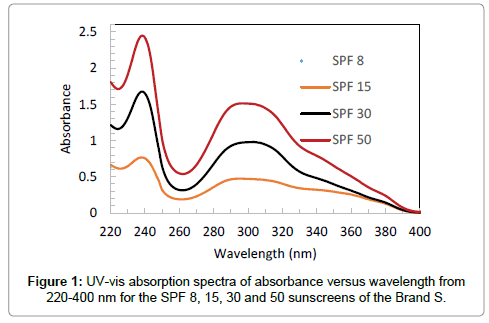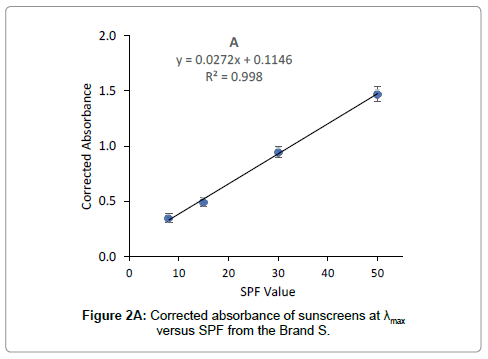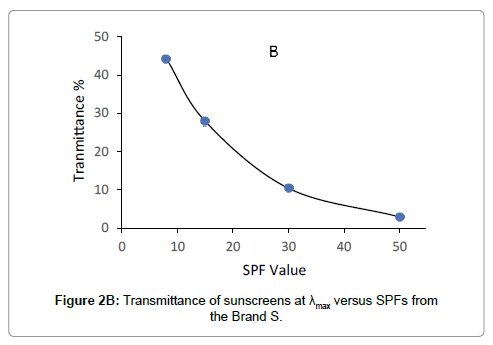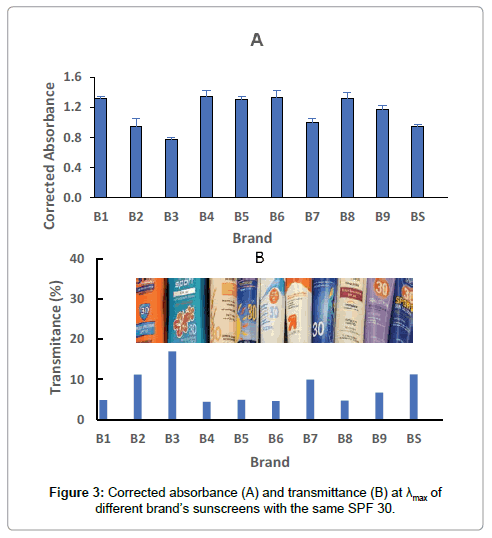Research Article Open Access
Rapid Comparison of UVB Absorption Effectiveness of Various Sunscreens by UV-Vis Spectroscopy
Ju Chou*, Ted J. Robinson and Hui Doan
Department of Chemistry and Physics, Florida Gulf Coast University, Fort Myers, FL 33965, USA
- *Corresponding Author:
- Ju Chou
Department of Chemistry and Physics
Florida Gulf Coast University
Fort Myers, FL 33965, USA
Tel: 12395901457
E-mail: jchou@fgcu.edu
Received Date: March 16, 2017 Accepted Date: March 22, 2017 Published Date: March 27, 2017
Citation: Chou J, Robinson TJ, Doan H (2017) Rapid Comparison of UVB Absorption Effectiveness of Various Sunscreens by UV-Vis Spectroscopy. J Anal Bioanal Tech 8: 355. doi: 10.4172/2155-9872.1000355
Copyright: © 2017 Chou J, et al. This is an open-access article distributed under the terms of the Creative Commons Attribution License, which permits unrestricted use, distribution, and reproduction in any medium, provided the original author and source are credited.
Visit for more related articles at Journal of Analytical & Bioanalytical Techniques
Abstract
Sunscreens are used to absorb or block harmful sunlight especially ultra violet (UV) radiation. An UV-vis spectrometer was employed to measure absorbance of sunscreen products. The same brand’s sunscreens with sun protection factor (SPF) of 8, 15, 30, and 50 were tested under identical experimental conditions. The results show that the UV absorbance and the transmittance of the sunscreens are associated with the SPF value. The maximum absorbance of the sunscreens measured between 280 to 320 nm (UVB region) is linearly proportional to the SPF value with a correlation coefficient of 0.998 using the same brand’s sunscreens. Thus, the absorbance can be used to evaluate the efficiency of a sunscreen that absorbs or blocks UVB radiation. Several commercial sunscreens of different brands but with the same SPF 30 were compared. The results confirmed that, although different brand sunscreens with the same SPF varied slightly in UV absorbance, they all offer adequate protection against UVB radiation. The utilization of UV-Vis spectroscopy is found to be particularly effective for determination of sunblock efficiency.
Keywords
Uv-vis spectroscopy; Sunscreens; Spf; Uvb radiation
Introduction
The sun emits three types of ultra violet (UV) radiation: UVA (320- 400 nm), UVB (280-320 nm) and UVC (200-280 nm). Among them, UVC radiation contains the shortest wavelength and has the highest energy. However, since it is blocked by atmospheric ozone layer, UVC does not reach the Earth’s surface and cannot affect humans. Both UVA and UVB rays are able to penetrate the ozone layer and reach the earth’s surface. Thus, they are harmful to humans by damaging human skin potentially causing sunburns and skin cancer etc. [1-3]. About 90 percent of all skin cancers are associated with exposure to the sun’s harmful UV radiation. Sunscreen is one of the key strategies that help greatly reduce excess exposure to the harmful UV rays [4-7].
Sunscreens help shield human body from the sun’s radiation in two ways dependent on their ingredients by either absorbing it or reflecting it away from the skin. The assessment of efficiency of a sunscreen is based on sun protection factor (SPF) which is used by all sunscreen manufacturers to rate their sunscreen’s ability to absorb UVB radiation [6]. The most effective sunscreens should block or absorb both UVA and UVB radiation, but UVA is not discussed in this study since it is not evaluated by SPF yet [8-10]. SPF values can be obtained invivo by determining the amount of time a person can stay in the sun without experiencing a sunburn [10], but it has the undesirable effect of involving the human skin test.
Due to high cost and time consumption of in-vivo SPF determination methods, the SPF of sunscreens was determined by ultraviolet spectrophotometry which substitutes in the in-vivo method [11-15]. UV-vis spectroscopy was employed to measure absorbance at different wavelengths and a SFP was calculated using the absorbance measured and mathematic equation [13,14]. The calculation requires to use normalized product function at different wavelengths proposed by Sayre, et al. in order to obtain SFP [11]. More practically, people want to find out which sunscreen will provide a better skin protection against UVB rays, but there is no direct correlation reported between the absorbance of sunscreens and the SPF value so far. In this study, a rapid analytical method to evaluate sunscreen’s ability to absorb or block UVB radiation using a UV-vis spectrophotometer. A direct correlation between the absorbance and the SPF was examined and it allowed to assess sunblock effectiveness without using the normalized production function.
UV-vis spectrophotometer is able to measure the intensity of light passing through a sample or measure absorbance [12-15]. In this study, it was used to measure absorbance of sunscreen solutions. For the first time, a direct correlation between the absorbance and the SPF of sunscreens was established. Sunscreen’s effectiveness to absorb or block UVB radiation from different manufacturers was then compared. Thus, this paper presents the application of an UV-vis spectrophotometric analysis on sunscreen’s effectiveness.
Experimental
Chemicals
70% of rubbing alcohol (isopropyl alcohol) was purchased from a local drug store. All sunscreens of different brands and with different SPF (8, 15, 30, 50) were purchased from local stores.
Experimental procedure
0.02 g of a sunscreen sample was weighed and transferred into a 100 mL volumetric flask. About 70 ml of 70% isopropyl alcohol was added into the volumetric flask. The solution was well shaken and then was diluted to the mark with the 70% isopropyl alcohol.
Three trials were prepared for each sunscreen product and the absorbance of each solution was scanned from 220 to 400 nm. The maximum absorbance was recorded and then was corrected to the same mass of 0.0200 g. The corrected absorbance was calculated by the following formula:
 (1)
(1)
The mean of corrected absorbance of the three measurements were calculated for accuracy and consistency.
The transmittance (T) of a sunscreen solution was calculated from the absorbance (A) based on the following equation:
A = -log(T) (2)
UV-vis spectroscopy
A double beam Shimadzu UV-Vis Spectrophotometer with 1 cm quartz cuvettes was used for absorbance measurements. One quartz cuvette was filled with 70% isopropyl alcohol as a reference and another one was filled with a sunscreen solution. Prior to analysis, the sample cell was rinsed three times with 1 mL of the sample solution. The UVvis spectrophotometer was set to scan from 220 nm to 400 nm and the maximum wavelength from 290 nm to 320 nm was recorded after completing the scan.
Results and Discussion
Sunscreens with different SPF values of 8, 15, 30 and 50 from the same brand (Abbreviated as Brand S or BS) were selected to investigate a correlation between the absorbance and transmittance with the SPF value. Figure 1 shows typical plots of UV-vis absorption spectra of the four sunscreens from 220 to 400 nm. All sunscreens have two absorption peaks from 220 to 400 nm. The first peak was centered around 240 nm (UVC region). The second peak was centered around 300 nm (UVB region) for SPF 30 and 50, and 290 nm for the SPF 8 and 15. The UV-vis spectra of the four sunscreens indicate that they all are able to absorb both UVB and UVC rays. Since UVC radiation does not reach the earth, it is not discussed here. This study only focused on the UVB radiation and only the absorption peak centered around 300 nm was discussed. The wavelength at which absorbance is highest is called the maximum wavelength or λmax, and the absorbance at the λmax for all sunscreens is used.
Absorbance of a substance is generally dependent on the concentrations of the tested solution according to Beer’s law: A=�?bc (c is the concentration of the tested solution, b is the path length of the light and �? is the molar absorptivity.) In order to compare sunscreen’s effectiveness in absorbing the sun’s UVB rays, the same mass of each sunscreen must be used. Thus, a corrected absorbance was calculated as mentioned in the Experimental Section and the corrected absorbance at the λmax is used for the following discussion.
The corrected absorbance at λmax of the four sunscreens from the same brand versus the SPF was plotted as shown in Figure 2. The results show that the corrected absorbance of the sunscreen is directly related to SPF of the sunscreens. For the same brand sunscreen product, the corrected absorbance is linearly proportional to SPF. The higher SPF of a sunscreen is, where the higher absorbance was observed. An effective sunscreen is one that absorbs UV radiation in the 290 to 320 nm region to prevent the UVB rays from reaching and damaging human skin. Thus, the direct correlation observed between the corrected absorbance and SPF allows to use the corrected absorbance to evaluate sunscreen products.
The UV-vis spectrometer not only measures the absorbance of a solution, but also provides transmittance. When light is not absorbed by a sunscreen solution, it transmits through the solution and reaches the skin. The more light a solution absorbs, the less light is transmitted through the sun screen solution, and the less UV radiation reaches the skin. Transmittance of the four SPF solutions was calculated according to Equation (2) in the Experimental section and was plotted versus SPF as shown in Figure 2B. The figure shows that the transmittance of the sunscreens is not linearly related to SPF as expected. The results also show that the higher SPF a sunscreen is, the lower transmittance is observed and thus more light is absorbed by the sunscreen. The common misunderstanding is that SPF 30 is twice as strong as SPF 15, which is not true. For example, SPF 15 can filter out 72% of UVB, while SPF 30 can block 90% which is not doubled. When the same amount of SPF 50 was applied, 97% of UVB was filtered, indicating that only 3% of the UVB rays transmits through the sunscreen.
Since the absorbance (not transmittance) is linearly proportional to the SPF, the absorbance is selected to evaluate the effectiveness of a sunscreen to absorb or block the UVB radiation. Though transmittance is not linearly proportional to the SPF, it provides quantitative information on what percent of the UVB radiation is blocked or filtered out by a sunscreen.
Nine different brands of sunscreen products (B1 to B9) with the same SPF 30 were evaluated with the same procedures discussed above and they were compared with the Brand S sunscreen. The corrected absorbance of each sunscreen solution was obtained and the average corrected absorbance from three trials were shown in Figure 3A. Though these sunscreens have the same SPF 30, they have slightly different absorbance indicating that they absorb different percentages of UVB radiation. Among the nine brands of sunscreen products tested, six brands have higher absorbance than Brand S, indicating more UVB rays are filtered out by the six sunscreens. Two brands (B2 and B7) have comparable absorbance with Brand S. According to the label from the two brands, one has an identical formula as the Brand S product. This explains why the two brands have similar absorbance. Only one brand’s sunscreen has lower absorbance than Brand S, indicating it blocked less UVB radiation than Brand S.
Transmittance of all 10 sunscreens were calculated based on the corrected absorbance and shown in Figure 3B. Transmittance varied from 4% to 17% (most of them were from 4 to 11%), indicating that most of them provide adequate protection against UVB radiation since most of them absorb 89% or more of UVB rays and allow 11% or less to reach the skin under the experimental condition.
This study demonstrates that sunscreens absorb UVB rays and decrease the amount of UVB rays allowed to reach the skin. The absorbance of the sunscreens from the same brand is linearly proportional to the labeled SPF. However, the sunscreens of different brands with the same SPF do not provide the same UVB protection. This claim is based on the proposition that a sunscreen with a higher UVB absorbance will block more radiation and will be more effective than a sunscreen with a lower UVB absorbance. It should be noted that a sunscreen with both UVA and UVB protection is recommended, but UVA is not discussed in this study. The method developed in this study can provide a quantitative mean to evaluate the effectiveness of a sunscreen to block or absorb UVB rays.
Conclusion
In conclusion, this study shows a direct correlation between the absorbance that evaluates sunscreen efficiency to block UVB radiation and the sunscreen’s SPF. The analytical method developed allows to rapidly compare the sunscreen’s effectiveness to absorb or block UVB radiation and might provide a rapid and a useful alternative method for measuring sunscreen effectiveness in addition to in vivo SPF determination. With the same SPF 30, though the sunscreens of different brands block different amount of UVB rays, they all unequivocally and reliably absorb or block UVB rays for skin protection.
Acknowledgments
Department of Chemistry and Physics at Florida Gulf Cost University supported this work.
References
- Wolf R, Tuzun B, Tuzun Y (2001) Sunscreens. Dermatol Ther 14: 208-214.
- Pleasance ED, Cheetham RK, Stephens PJ, McBride DJ, Humphray SJ, et al. (2010) A comprehensive catalogue of somatic mutations from a human cancer genome. Nature 463: 191-196.
- Rass K, Reichrath (2008) UV damage and DNA repair in malignant melanoma and nonmelanoma skin cancer. J Adv Exp Med Biol 624: 162-178.
- Serre I, Cano JP, Picot MC, Meynadier J, Meunier L (1997) Immunosuppression induced by acute solar-simulated ultraviolet exposure in humans: prevention by a sunscreen with a sun protection factor of 15 and high UVA protection. J Am Acad Dermatol 37: 187-194.
- Reinau D, Osterwalder U, Stockfleth E, Surber C (2015) The meaning and implication of sun protection factor. Brit J Dermatol 173: 1345.
- Burnett ME, Wang SQ (2011) Ultraviolet Radiation and the Skin: An In-Depth Review. Photodermatol Photoimmunol Photomed 27: 58.
- Autier P, Boniol M, Severi G, Dore JF (2001) Quantity of sunscreens used in European students. Brit J Dermatol 144: 288.
- Gasparro FP, Mitchnick M, Nash JF (1998) A Review of Sunscreen Safety and Efficacy. Photochem Photobiol 68: 243.
- Moyal DD, Fourtanier AM (2008) Broad-spectrum sunscreens provide better protection from solar ultraviolet-simulated radiation and natural sunlight-induced immunosuppression in human beings. J Am Acad Dermatol 58: 149-154.
- Bissonnette R, Allas S, Moyal D, Provost N (2000) Comparison of UVA protection afforded by high sun protection factor sunscreens. J Am Acad Dermatol 43: 1036-1038.
- Sayre RM, Agin PP, Levee GJ, Marlowe E (1979) A comparison of in vivo and in vitro testing of sunscreening formulas. Photochem Photobiol 29: 559.
- Walters C, Keeney A, Wigal C, Johnston C, Cornelius R (1997) The Spectrophotometric Analysis and Modeling of Sunscreens. J Chem Edu 74: 99.
- Dutra E, da Costa e Oliveira DG, Kedor-Hackmann E, Miritello R, Santoro (2004) In vitro sun protection factor determination of herbal oils used in cosmetics. Braz J Pharm Sci 40: 381.
- Mbanga L, Mpiana PT, Mumbwa AM, Bokolo K, Mvingu K, et al. (2014) Determination of Sun Protection Factor (SPF) of Some Body Creams and Lotions Marketed in Kinshasa by Ultraviolet Spectrophotometry. J Phys Chem Sci 2: 1.
- Azevedo JS, Viana NS, Vianna Soares CD (1999) UVA/UVB sunscreen determination by second-order derivative ultraviolet spectrophotometry. Farmaco 54: 573-578.
Relevant Topics
Recommended Journals
Article Tools
Article Usage
- Total views: 31293
- [From(publication date):
April-2017 - Apr 05, 2025] - Breakdown by view type
- HTML page views : 29567
- PDF downloads : 1726




